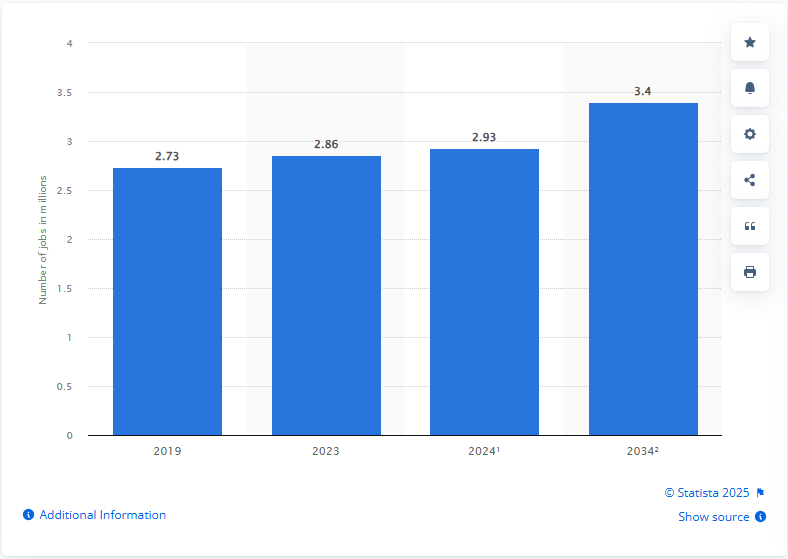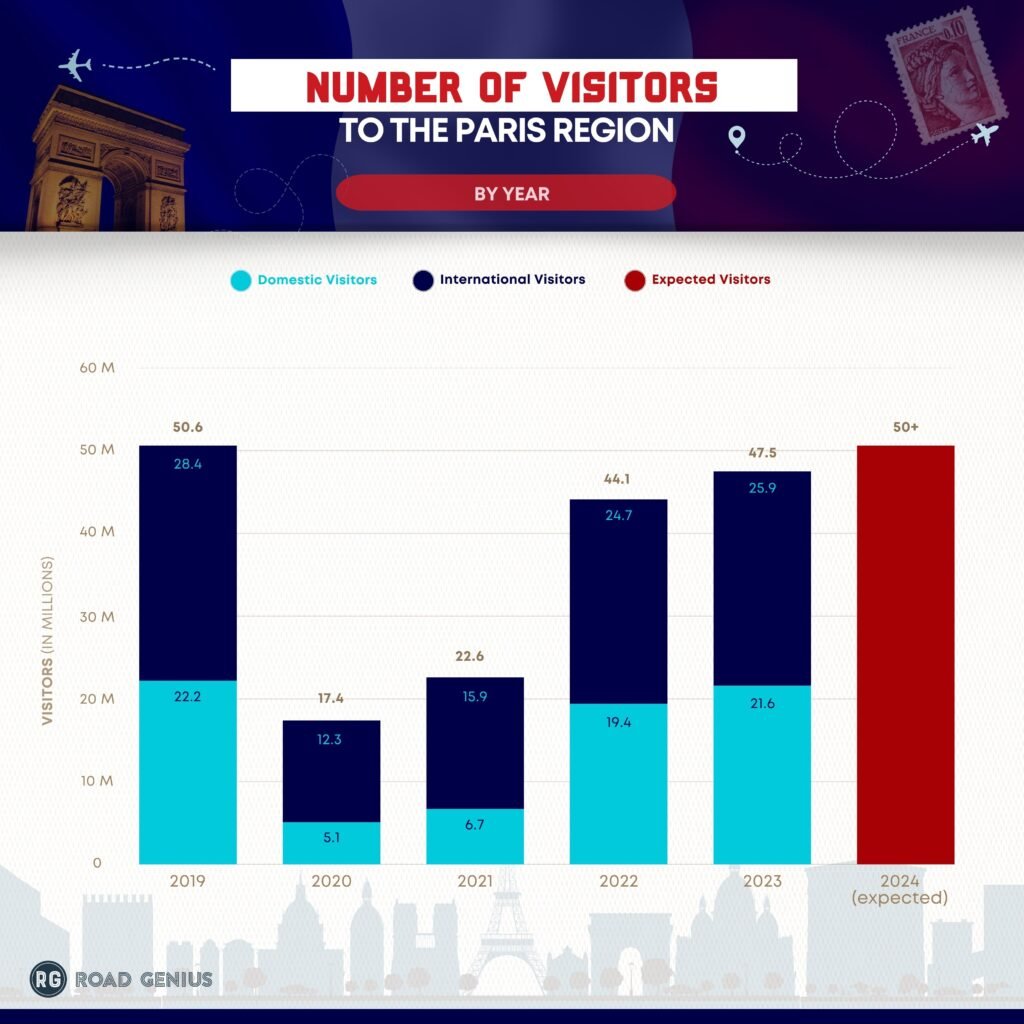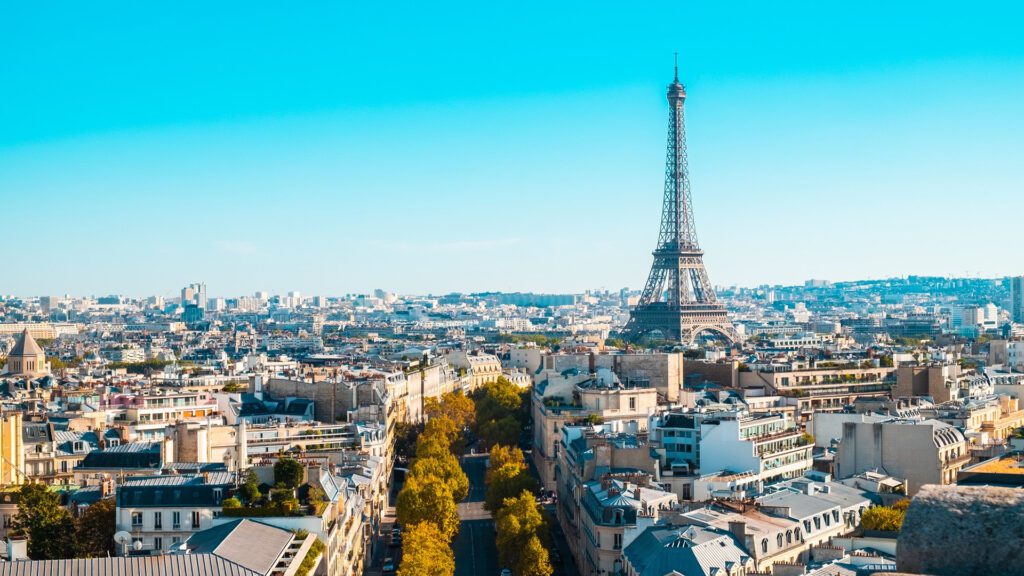France remains one of the most visited countries in the world, offering a rich cultural heritage, world-famous cuisine, and iconic landmarks. From bustling cities to charming countryside villages, there is something for everyone.
However, the French tourism sector—like much of the global industry—experienced a steep decline during the COVID-19 pandemic, only to rebound strongly in recent years.
Below is a comprehensive look at France’s tourism trends, key statistics, and highlights.
Overview of France Tourism
France is the world’s leading tourist destination, with over 100 million visitors in 2023. The country will remain the number one tourist destination until at least 2025.
However, France’s tourism sector suffered significant setbacks during the 2020 pandemic, experiencing the third-highest tourism loss worldwide—a 66% drop in arrivals and a €103 billion drop in GDP contribution. This profoundly impacted France’s economy, highlighting the crucial role of tourism in the nation’s financial health. France rebounded as the global situation improved, showing a 12.3% growth in the first quarter of 2023.
How Many Tourists Visit France Each Year?
Leading Global Destination: France attracted 100 million foreign tourists in 2023, reaffirming its top ranking.
Historical Pandemic Impact: In the seven months following early 2020, tourist arrivals plummeted by 66%, but have shown strong signs of recovery.
Annual Visitor Patterns: Pre-pandemic, over 89 million foreign arrivals were documented, underscoring the scale of France’s tourism industry.
France Tourism Market Size and Growth
Market Size and Revenue
$20.03 Billion by 2024: France’s travel and tourism market is forecast to reach this figure.
CAGR of 0.86% (2024–2028): The industry’s moderate but steady growth reflects gradual recovery and long-term resilience.
Hotels Segment: Expected to reach $10.69 billion in revenue by 2024, making it the largest share.
Online Sales: Projected to account for 77% of total tourism revenue by 2028, highlighting the shift to digital booking platforms and e-commerce.
International Tourism in France
France’s Travel and Tourism Industry
Historic Spending: International tourist expenditure reached €44.3 billion in 2017, climbing to €56.2 billion in 2019 (a 5% increase).
GDP Contribution: Travel and tourism accounted for 9.7% of France’s GDP in 2013, with the figure evolving in subsequent years.
Global Leader: With 100 million foreign visitors in 2023, France will remain the most visited country worldwide.
Pandemic Recovery: Despite setbacks, rising visitor numbers and strong growth rates in 2023 indicate robust renewal. The pandemic significantly impacted French tourism, causing substantial revenue losses and job impacts within the sector. However, recovery trends and the resurgence of tourism in various regions of France illustrate the country’s appeal as a top travel destination.
Domestic Tourism in France
Domestic Tourist Numbers and Trends
Future Projections: Domestic tourism expenditure in France is expected to reach €131.4 billion by 2028.
Recent Figures: Nearly €115 billion was spent domestically in 2018.
Preference for Home Holidays: 87% of French people on holiday choose to remain in France.
Package Holidays: Domestic travelers spent €7.2 billion on package trips in 2015, an indicator of the popularity of all-inclusive local getaways.
Outbound Tourism from France
French Outbound Tourist Numbers and Trends
Top Foreign Destinations: Spain and Italy rank as the most-visited countries by French travelers, with the UK and Morocco also proving popular.
Post-Pandemic Uptick: French outbound tourism spending began rebounding in 2023 but remains below pre-pandemic levels.
Purpose of Travel: Ranges from leisure vacations and business travel to visits with friends and family.
Most Popular Tourist Destinations in France
Popular Destinations for People Who Visit France
Disneyland Paris: Maintains its status as the country’s most-searched attraction, boasting around 450,000 monthly searches. Tourist accommodation establishments in France are highly popular and significant, with specific statistics on overnight stays and the volume of tourist activity for the year 2024 highlighting their impact on tourism in the region.
Avignon: Second most popular, with 144,000 monthly searches.
Additional Favorites: Mont Saint Michel, Carcassonne, and Le Havre, all praised for their cultural and historical appeal.
Most Popular Tourist Attractions in France
Top Attractions for Inbound Tourists
Eiffel Tower: Leads in social media mentions (24.8%), an iconic Parisian symbol.
Louvre Museum: Second in social media buzz, with 11% of mentions, welcomes around 8 million visitors annually.
Palace of Versailles & Mont Saint-Michel: Both are significant crowd-pleasers known for their historical and architectural grandeur.
French Riviera (Côte d’Azur): Popular among beachgoers and yachters, featuring upscale resorts and scenic Mediterranean views.
Tourism Revenue and Expenditure
As of 2019, tourist spending in France, the world’s leading destination, had reached a record €56.2 billion, reflecting a 5% year-on-year increase. While the pandemic halted this climb, revenues have since bounced back, evidenced by the industry’s latest rebound in 2023. In pre-pandemic years, the contribution of travel and tourism to the French GDP hovered around 9–10%, and ongoing recovery efforts aim to restore or surpass these levels.
Revenue Generated by Tourism in France
The tourism sector in France is a powerhouse of economic activity, generating substantial revenue. In 2019, international visitors spent an impressive €56.2 billion, a 5% increase from the previous year. This growth underscores France’s status as one of the world’s leading tourist destinations. The revenue generated by tourism in France is projected to soar, with estimates suggesting it will reach €248.1 billion by 2028.
A significant portion of this revenue comes from international visitors, who flock to France’s most popular tourist attractions, such as the Eiffel Tower and Disneyland Paris. However, domestic tourism spending also plays a crucial role, accounting for around 70% of the total revenue. Tourism is not just a major contributor to France’s economy, representing about 9.7% of GDP, but also drives job creation. By 2028, the sector is expected to support over 2.9 million jobs, highlighting its importance in sustaining France’s economic health.
Tourism Employment and Industry Trends
Jobs Created: Official data shows that tourism supported 2.8 billion jobs in 2016 (directly and indirectly), though this figure likely reflects millions, not billions.
Direct vs. Indirect: In 2017, 1.2 billion jobs were described as directly from tourism, with another 1.1 billion attributed indirectly—again, these large numbers are presumably measured at scale or regionally.
Disneyland Paris: Employed 15,200 people in 2016, showcasing the massive draw of France’s leading theme park.

Employment in the Tourism Industry in France
The tourism industry in France is a vital source of employment, supporting over 2.93 million jobs in 2024. This figure represents approximately 10.9% of total employment in the country, making tourism one of France’s largest industries. Most of these jobs are concentrated in the accommodation and food services sectors, with hotels, restaurants, and cafes being major employers.
Looking to the future, the tourism industry is poised to create even more job opportunities. By 2028, it is estimated that the sector will support over 3.2 million jobs, reflecting its ongoing growth and significance. The industry’s contribution to the economy is substantial, accounting for around 9.7% of GDP. As the sector continues to expand, it is expected to generate over €248.1 billion in revenue by 2028, further bolstering France’s economy and providing a steady stream of new job opportunities.
Regional Tourism in France
Ile de France (Paris): This city hosts an array of cultural attractions and typically sees over 30 million visitors per year.
Provence-Alpes-Côte d’Azur: Famed for Mediterranean beaches, lavender fields, and a thriving cultural scene.
Auvergne-Rhône-Alpes, Occitanie, Nouvelle-Aquitaine, and Corsica: Each region offers distinct landscapes and cultural heritage, drawing millions of tourists annually.
Tourism in Other Regions of France
While Paris remains France’s most popular tourist destination, other regions also attract significant numbers of visitors, each offering unique attractions and experiences. The French Riviera, or Côte d’Azur, is a prime destination for beachgoers and yacht enthusiasts, known for its glamorous resorts and stunning Mediterranean coastline.
With its breathtaking châteaux and picturesque countryside, the Loire Valley is a favorite among tourists seeking a blend of history and natural beauty. The Alps, home to world-renowned ski resorts like Chamonix and Courchevel, draw winter sports enthusiasts from around the globe.
France’s rural regions and charming villages also captivate visitors, offering a tranquil escape and a taste of traditional French life. Lyon, celebrated for its culinary excellence, attracts foodies eager to indulge in its gastronomic delights. Bordeaux, famed for its wine production, is a must-visit for enthusiasts.
Normandy, rich in history, is another popular destination, with the city of Bayeux housing the famous Bayeux Tapestry. Each of these regions contributes to the diverse and rich tapestry of France’s tourism landscape, ensuring visitors have a wealth of options beyond the allure of Paris.
Paris Tourism Statistics

Visitor Numbers and Trends in Paris
44 Million Tourists in 2022: Paris remains one of the most visited cities globally.
Accommodation Choices: 53% of visitors opt for hotels during overnight stays, benefiting the city’s strong hospitality sector.
City of Culture: Paris’s unique blend of historical landmarks, world-class museums, and celebrated gastronomy makes it a premier destination.
Sources
- UN: Global and regional tourism performance
- Statista: Travel and Tourism France
- French Government: Plan de reconquête et de transformation du tourisme
- Statista: Most Visited Tourism Attractions in France
- Eurostat: Trips by Destination Type
- Memento de Tourisme: La Frequentation des Hebergements
- Statista: Domestic Tourism Expenditure in France
- Statista: Number of Domestic Trips by Type in France
- Macro Trends: France Population 1950–2024
- Brussels Times: Paris remains most visited city in the world
- Visit Paris Region: Key Features of the Paris Region Destination
- Numbeo: Cost of Living in France
- Paris Digest: Tourism in Paris
In Summary, France Tourism Statistics
Despite facing one of the most severe downturns in global tourism, France’s strong comeback in 2023 illustrates its resilience and enduring appeal.
With visitor numbers pushing past 100 million, the nation’s rich cultural offerings, culinary heritage, and iconic landmarks will likely remain the world’s top tourist destination well into 2025 and beyond.
Frequently Asked Questions about France Tourism
How many tourists visit France each year?
France welcomed over 100 million tourists in 2023, maintaining its status as the world’s leading destination.
What is France’s world ranking in tourism?
France consistently ranks as the number one tourist destination globally, attracting millions of international visitors annually.
Which country visits France the most?
Among other European countries, the United Kingdom, Germany, and Belgium are some of the top nations whose residents frequently visit France.
What is tourism in France like?
Tourism in France offers a rich tapestry of experiences, from exploring iconic landmarks like the Eiffel Tower and the Louvre Museum to enjoying the scenic beauty of the French Riviera and the historical charm of regions like Normandy and Provence.
How long do tourists typically stay in France?
The average length of stay for tourists in France varies but is generally around 7 to 10 days. This allows visitors to explore both major cities and the picturesque countryside.
What are some of the most popular tourist attractions in France?
Popular tourist attractions include Disneyland Paris, the Eiffel Tower, Notre Dame de Paris, the Palace of Versailles, and the French Riviera.
How does tourism contribute to France’s economy?
Tourism accounts for a significant portion of France’s economy, representing about 9.7% of GDP and supporting millions of jobs.
How has the COVID-19 pandemic affected France’s tourism sector?
The pandemic resulted in a dramatic decline in inbound tourist arrivals and revenue. However, the sector has shown strong signs of recovery, with visitor numbers rebounding in recent years.
What are the leading inbound and outbound travel markets in France?
France’s leading inbound markets include other European countries, while French travelers frequently visit Spain, Italy, and Morocco as part of outbound tourism.
How does domestic tourism compare to international tourism in France?
Domestic tourism expenditure is substantial, with French residents often choosing to holiday within their own country, contributing significantly to the tourism market size.
These FAQs provide insights into France’s tourism sector’s current trends and statistics, highlighting its importance to its economy and appeal as a top travel destination.





